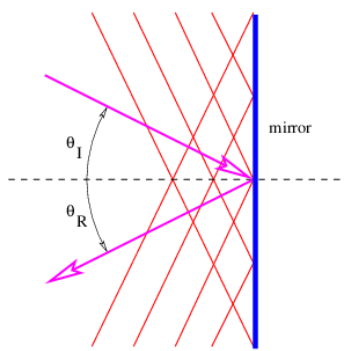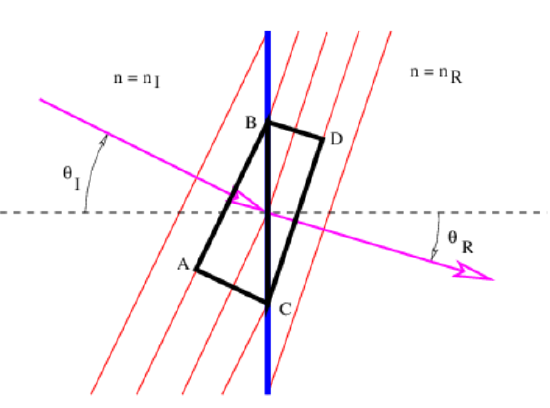3.1: Reflection and Refraction
( \newcommand{\kernel}{\mathrm{null}\,}\)
Most of what we need to know about geometrical optics can be summarized in two rules, the laws of reflection and refraction. These rules may both be inferred by considering what happens when a plane wave segment impinges on a flat surface. If the surface is polished metal, the wave is reflected, whereas if the surface is an interface between two transparent media with differing indices of refraction, the wave is partially reflected and partially refracted. Reflection means that the wave is turned back into the half-space from which it came, while refraction means that it passes through the interface, acquiring a different direction of motion from that which it had before reaching the interface.

Figure 3.1.1: shows the wave vector and wave front of a wave being reflected from a plane mirror. The angles of incidence, θI, and reflection, θR, are defined to be the angles between the incoming and outgoing wave vectors respectively and the line normal to the mirror. The law of reflection states that θR = θI. This is a consequence of the need for the incoming and outgoing wave fronts to be in phase with each other all along the mirror surface. This plus the equality of the incoming and outgoing wavelengths is sufficient to insure the above result.

Refraction, as illustrated in Figure 3.1.2:, is slightly more complicated. Since nR>nl, the speed of light in the right-hand medium is less than in the left-hand medium. (Recall that the speed of light in a medium with refractive index n is Cmedium =cYac /n. ) The frequency of the wave packet doesn’t change as it passes through the interface, so the wavelength of the light on the right side is less than the wavelength on the left side.
Let us examine the triangle ABC in Figure 3.1.2:. The side AC is equal to the side BC times sin(θI). However, AC is also equal to 2λI, or twice the wavelength of the wave to the left of the interface. Similar reasoning shows that 2λR, twice the wavelength to the right of the interface, equals BC times sin(θR). Since the interval BC is common to triangles ABC and DBC, we easily see that
λIλR=sin(θI)sin(θR)
Since λI=cIT=cvacT/nI and λR=cRT=cvacT/nR where cI and cR are the wave speeds to the left and right of the interface, cvac is the speed of light in a vacuum, and T is the (common) period, we can easily recast the above equation in the form
nIsin(θI)=nRsin(θR)
This is called Snell’s law, and it governs how a ray of light bends as it passes through a discontinuity in the index of refraction. The angle θI is called the incident angle and θR is called the refracted angle. Notice that these angles are measured from the normal to the surface, not the tangent.


